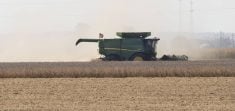As China’s record heatwave starts to subside, farmers are assessing the damage caused by a prolonged drought while the government is urging them to replant or switch crops where they can.
More than 70 days of extreme temperatures and low rainfall have wreaked havoc along the basin of the Yangtze, which supports more than 450 million people as well as a third of the country’s crops.
Though rain was expected at the end of August and in early September, farmers near the depleted Poyang Lake in central China’s Jiangxi province, normally a flood outlet for the Yangtze, worry that the heat has already done too much damage.
Read Also

New ranking elevates Assiniboine College to national research elite
Brandon’s Assiniboine College is 47th in a national ranking measuring research dollars and output at publicly funded institutions in Canada.
The agriculture ministry in an emergency notice Aug. 23 called on farmers to harvest and store rice and act to strengthen grain growth in coming weeks. In areas where the drought has already inflicted heavy damage, farmers are encouraged to switch to late-autumn crops like sweet potatoes, but that is no easy task.
“We can’t switch to other crops because there’s no land,” said Hu Baolin, a 70-year-old farmer in a village on the outskirts of Nanchang, Jiangxi’s provincial capital.
He said his plants, including oil rapeseed and sesame, were far less developed compared to normal years, and his pomelos were just a third of their usual size.
The agriculture ministry said the hot weather posed a “serious threat” to autumn grain production and urged local governments to “do everything possible” to find more water.














